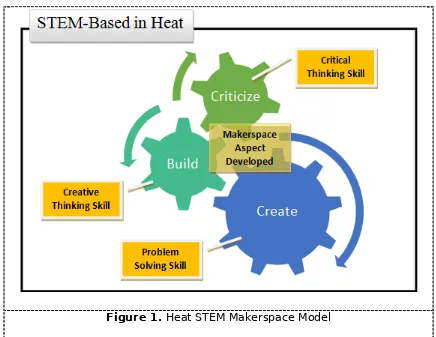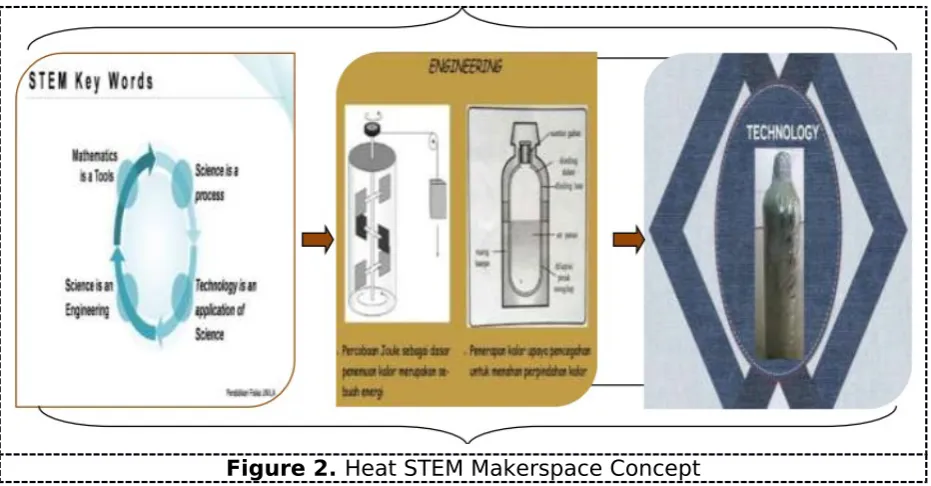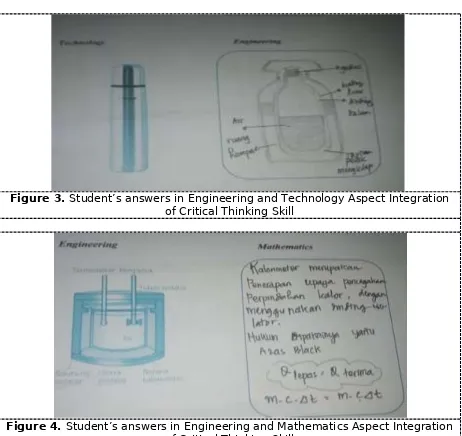Developing STEM Learning Makerspace for Fostering
Student’s 21st Century Skills in The Fourth Industrial
Revolution Era
Abdurrahman1
1Physics Education Department of Lampung University
Jl. Sumantri Brojonegoro No. 01 Gedong Meneng, Rajabasa Kota Bandar Lampung, 35141, INDONESIA
E-mail: 1[email protected]
Abstract. The need for higher education to respond is urgent as the power of 4IR technologies and 21st century challenges for either positive social impacts or devastating environmental damage. Recent researches on how to make an alternative solution in the form of STEM learning methods and strategies to address the challenges of the 21st century and 4IR technology had been widely investigated. However, the implementation in the term of integrated-STEM field. The implementation of integrated STEM was still fragmented so that the essence of a whole STEM meaning had not been described. Recent studies oriented to the development of learning strategies had not emphasized the makerspace concept, even though a good understanding of makerspace concept was the start point in implementing integrated-STEM essence. Makerspace in STEM is the deliberate positioning of student learning in contexts that require the drawing together of skills and knowledge from the areas of science, technology, engineering, and mathematics to create, construct, and critique a product or artefact. The research presented in this paper describes a type of STEM makerspace that was defined by its purpose: to foster Student’s 21st Century Skills in 4IR technologies and 21st century challenges. This approach is innovative into STEM education. A new model of STEM makerspace that is currently being validated in an extended, funded project framed this research that involved secondary students in Indonesia. A large set of qualitative data was collected, this paper reports on the progress and reflections of the teacher education students, and shares insights into their personal learning and development as teachers. A quasi-experimental study in Heat transfer STEM makerspace was conducted. Results of samples paired t-test showed Sig.(2-tailed) 0.000 which indicated that there were differences in results pretest and posttest when STEM makerspace was implemented with the effect size data was in a high category.
1. Introduction
The Fourth Industrial Revolution (4IR) was a concept widely discussed in many venues. Recent papers investigated how 4IR will shape the future of education, gender and employment [1]. In response to 4IR challenges, people were required to accelerate their workforce reskiling [2]. The fact that 4IR technologies will bring profound and rapid change seems all but certain. this is in line with
the challenges of the 21st century which also require consideration in the field of education. The need for higher education to respond is urgent as the power of 4IR technologies and 21st century challenges for either positive social impacts or devastating environmental damage. The substantial of the education curriculum needed to be changed to allow students develop their capacities in various fields, especially the rapidly emerging areas of STEM (Science, Technology, Engineering, and Mathematics) [3][4].
The education curriculum applied in Indonesia was seen as being in line with the challenges of the 21st century and 4IR technology. However, the implementation of the curriculum still indicated some weaknesses which lead to the conclusion that educators and instructors should innovate to be able to create a learning circumtances that was able to guide students to develop the skills required so that they could compete in this millenial era. Recent researches on how to make an alternative solution in the form of STEM learning methods and strategies to address the challenges of the 21st century and 4IR technology had been widely investigated [5][6][7]. Besides that, the development of teacher professionalism programs in the field of STEM to address them to learning oriented to the 21st century and 4IR thinking frameworks had also been carried out [8]. The perception of STEM users in the field of content and career also showed positive responses that the development of education in the STEM context had the potential to solve problems about the quality of the learning process in the current era [9]. However, the implementation of integrated STEM was still fragmented so that the essence of a whole STEM meaning had not been described. Recent studies oriented to the development of learning strategies had not emphasized the makerspace concept, even though a good understanding of makerspace concept was the start point in implementing integrated-STEM essence.
This paper argues that makerspace in STEM is the provision of deliberate space or opportunity from student learning where students must combine skills and knowledge from the fields of science, technology, engineering, and mathematics to create, build, and criticize a product. Creative and practical ways to inspire students to plan, research, build and make when they participate in projects was through makerspaces at STEM [10]. Macerspace in STEM is different from project based learning, because makerspace products in STEM do not have to be in the form of projects such as tools, prototypes, or designs. However, concepts that can explain problems from certain situations are also products of STEM, but concepts are not projects. Makerspacescan be more than tinkering if there is a strengthening of the explicit connections between the curricula of mathematics, science, and technology and the end product or artefact [11]. Makerspace opportunities as informal science programs and define these as being less formal and intentionally different to more traditional approaches [12] They assert that this type of learning should be student-centred and presented in a way so as to provide choices to the learner, enabling them to explore as their interest prevails [12]. It had been described previously that the skills needed by students in the 21st century could be optimally achieved through STEM-based learning. The STEM model that was suitable to lead to the development of student skills was through the application of integrated STEM, while the nature of integrated STEM might be realized through makerspace STEM. Therefore, we develop makerspace in STEM-based learning to improve the skills students need in the 21st century.
2. Method
through the pretest and posttest scores by using inferential statistical analysis of t test. The analysis was also supported by the result of the effect size analysis to describe the level of impact of STEM makerspace
3. Result and discussion
In the first step, we develop STEM learning makerspace. In the second step, the effects of the model were discussed. Results of the expert’s validity analysis showed the STEM learning makerspace was feasible to be used. The content validity analysis showed the percentage of 83% which means very high and the construct validity analysis showed the percentage of 87% which also means very high. Finally, the model developed was called Heat STEM Makerspace which can be seen in figure 1.
Figure 1. Heat STEM Makerspace Model
We also examined the instrument used to measure student’s creative, critical, and problem solving thinking. The result of validity and reliability of instrument showed that the instrument was valid and reliable to be used.
The result of this study showed that the Heat STEM makerspace model was efficient to improve student’s 21st century skills in physics. The effectiveness of the model developed was described from some indicators, they were (a) the achievement of learning objectives, (b) the achievement of student’s learning activity, (c) the achievement of teacher’s performances, and (d) students’ positive responses [13].
The achievement of learning objectives in experimental class was described by tabel 1 which showed the improvement of students' skills significantly with the sig value < 0,05 at the real level of 5%, n-gain analysis also show that the model was effective to be used with mean value of n-gain were more
than 0,7. The result of effect size test using Cohen's showed the result that STEM heat makerspace gives effect in the high category, with value 0.90 for male and 0.99 for female.
Table 1. The enhancement of students’ 21st century skills in experimental class
Female Male
Average Pretest Value 43.00 38.16
Average Posttest Value 90.20 90.63
Average N-gain Value 0.81 0.84
Overall the achievement of students’ creative thinking, critical thinking, and problem solving skills based on posttest results was in high category. The achievement of student’s learning activity was described by observation score percentage of more than 70% which means in high category, and teacher’s performances got the percentage of more than 80% which means in a very high category.
Figure 2. Heat STEM Makerspace Concept
Figure 3. Student’s answers in Engineering and Technology Aspect Integration of Critical Thinking Skill
Figure 4. Student’s answers in Engineering and Mathematics Aspect Integration of Critical Thinking Skill
Figure 3 and 4 showed student’s critical thinking skill in STEM aspect with a good results, they created a visual form of their own representation of Heat basic concept. They focused on solve authentic problems of the product, including the application of product design, for example, express opinions, creation, testing, repairing aimed at scaling up of understanding of the concept of learners [14] . The teacher provides an opportunity for students to explore the skills they have, so that students make their own space to understand the material about heat. The teacher showed a best skill to provide the best reflection of every learning that takes place. So that the makerspace concept in this research was achieved where students and teachers work together to create a makerspace STEM learning model. By learning so much fun as it is, then any learners were given the opportunity to express and carry out their research plans of each to solve problems that would occur gender equality understanding of the concept because in the learning activities of each learner male and female students were given opportunities together to think about the concept of STEM to make the product as the application and use mathematics as a tool. Learning activities in the classroom between male and female created a social interaction which also could reduce gender disparity [14]
4.
ConclusionFrom the analysis and discussion, it can be concluded that the Heat STEM makerspace could be used for fostering student’s creative thinking, critical thinking, and problem solving skills in physics. The design model could guide the teacher help students to explore their best potential in STEM. Students also learn better because the model not only develops their 21st century skills but also their STEM literacy in physics so that the model can promote higher order thinking skills.
Acknowledgments
Reference
[1] World Economic Forum 2017 Realizing Human Potential in the Fourth Industrial Revolution – An Agenda for Leaders to Shape the Future of Education, Gender and Work (Paper, World Economic Forum, Geneva)
[2] World Economic Forum 2017 Accelerating Workforce Reskilling for the Fourth Industrial Revolution An Agenda for Leaders to Shape the Future of Education, Gender and Work (Paper, World Economic Forum, Geneva)
[3]
Stohlmann M, Moore, T J, McClelland J, and Roehrig, G H 2011
Middle School
Journal
43
1
[4]
Corlu M S, Capraro R M, and Capraro M M 2014
Education and Science
39
171
[5]
Wang M T and Degol J L 2017
Educational Psychology Review
291
[6]
Alvarez, A 2017
Globalization and Multinational Corporations' Impact on Ireland's
Educational Policies and Practices in Developing 21st-Century Skills Through
Science, Technology, Engineering, and Mathematics and Science Fair Competitions
in Schools Such as School C
(PhD Thesis. University of Southern California)
[7]
Han S, Capraro R, and Capraro M M 2015
International Journal of Science and
Mathematics Education
13
5
[8]
Chai, C S 2018
The Asia-Pacific Education Researcher
[9]
Christensen R, Knezek G, and Tyler-Wood T 2014
Computers in human behaviour
34
1
[10] Cooper J 2013 Retrieved from
http://www.edutopia.org/blog/maker-movement-moving-into-classrooms-vicki-davis
[11]
Blackley S, Sheffield R, Maynard N, Koul R, and Walker R 2017
Australian Journal of
Teacher Education (Online)
42
3
[12]
Krishnamurthi A and Rennie L J 2013 Retrieved from http://
www.afterschoolalliance.org/documents/STEM/Rennie_Krishnamurthi.pdf.
[13] Sunyono 2015 Model Pembelajaran Multipel Representasi (Yogyakarta: Media Akademi) [14]


